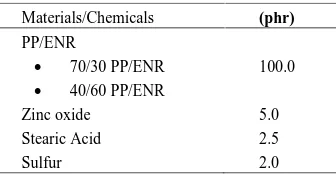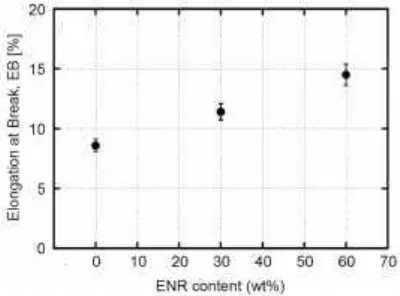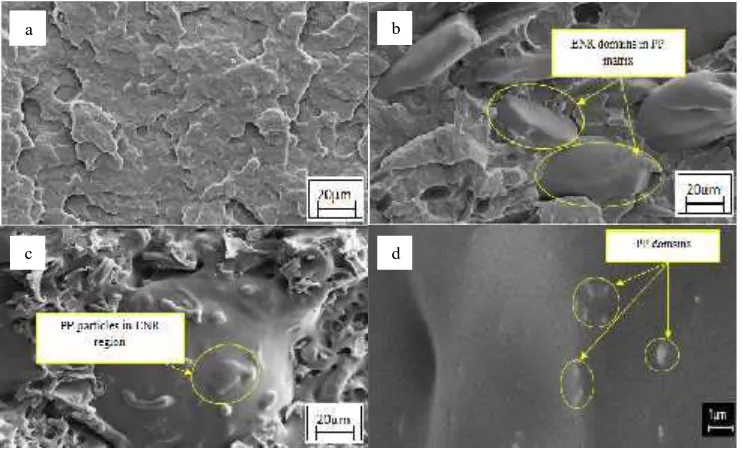Procedia Engineering 00 (2013) 000–000
The Malaysian International Tribology Conference 2013, MITC2013
Mechanical and morphological properties of polypropylene/epoxidized
natural rubber blends at various mixing ratio
Noraiham Mohamad
a, Nur Sharafina Zainol
a, Faisal Faris Rahim
a, Hairul Effendy Ab Maulod
b,
Toibah Abd Rahim
a, Siti Rahmah Shamsuri
a, Mohd Asyadi ‘Azam Mohd Abid
a, Mohd Yuhazri
Yaakub
a, Mohd Fadzli Abdollah
c, Mohd Edeerozey Abd Manaf
aaDepartment of Engineering Materials,
Faculty of Manufacturing Engineering,
bDepartment of Manufacturing Engineering Technology,
Faculty of Engineering Technology,
cDepartment of Automotive,
Faculty of Mechanical Engineering,
Universiti Teknikal Malaysia Melaka, Durian Tunggal, 76100 Melaka, Malaysia Phone: +606-3316976, Fax: +606-3316411, Email: [email protected]
Abstract
This research is to investigate the effect of mixing ratio on the properties of polypropylene (PP) incorporated with epoxidized natural rubber (ENR). The blends of PP/ENR were prepared by melt compounding using an internal mixer and vulcanized through sulfur curing. Mechanical testing such as tensile test, hardness test and impact test were performed to characterize the properties of PP/ENR blends. It was clearly observed that the increase of the ENR percentage increases the toughness and flexibility of the PP/ENR blends. In comparison to the pure PP, the 40/60 PP/ENR blend showed an improvement of elongation at break and impact strength, up to 68% and 56%, respectively. In contrary, the tensile strength and hardness decreases as the amount of PP decreases. The changes were associated to the properties imparted by the elastic chains of cross-linked ENR. The obtained properties showed good correlation with fracture surfaces observed in microscopy analysis performed by Field Emission Scanning Electron Microscope at a magnification of 500 and 5000-x.
© 2013 The Authors. Published by Elsevier Ltd.
Selection and peer-review under responsibility ofThe Malaysian Tribology Society (MYTRIBOS), Department of Mechanical Engineering, Universiti Malaya, 50603 Kuala Lumpur, Malaysia.
Keywords: Polypropylene; epoxidized natural rubber; blend; mechanical properties
1. Introduction
Thermoplastic elastomers (TPEs) belong to a class of material that combines physical properties of thermoplastic and elastomer. They exhibit properties typical of rubber materials but processability similar to thermoplastics. Blending of polymers is a common technology that frequently applied in order to develop a product with superior mechanical properties from inexpensive polymer material [1]. It is aimed to obtain materials, which as far as possible combine the advantages, but not the disadvantages of the individual polymers. Furthermore, TPEs give better material utilization than thermosetting materials because the scraps and rejects can be recycled and re-worked [2].
Polypropylene (PP) is an additional polymer with a large molecular weight distribution [4]. There are three types of PP, i.e., atatic (aPP), isotactic (iPP) and syndiotactic (sPP) [5]. PP has wide range of application due to its unique properties such as high melting temperature, low density, high chemical resistance, and resistance to heat. On the other hand, PP exhibits poor impact strength which gives limitation to several other applications [6].
Epoxidized natural rubber (ENR) is a material of great interest; exhibiting a double functionality for crosslinking (double bonds and epoxy site) while retaining most of the properties of natural rubber [7]. The epoxidation of natural rubber can be performed using peracid which is generated from the reaction of formic acid and hydrogen peroxide [8]. The properties of ENR are gradually changed with increasing degree of epoxidation [8]. The presence of epoxy groups in rubber chains imparts great properties to natural rubber such as oil resistance, low gas permeability, good wet grip and high damping characteristics [9-11].
The main objective of blending elastomeric phase (ENR) into PP is to improve its flexibility and behaviour at low temperatures [12]. In polymer blends with a crystallizable component, thefinal properties are determined by: (1) mode and state of dispersion of rubbery domains in the crystalline matrix; (2) the texture, dimensions and size distribution of spherulites of the matrix; (3) the inner structure of spherulites, i.e. lamellar and inter lamellar thickness; (4) physical structure of inter spherulitic boundary regions and amorphous inter lamellar regions; and (5) the adhesion between the rubbery domains and the crystalline matrix [13]. In a study by Koshy et al. (re-stated in [13]); the crystallinity of the blends decreased with the increase in NR content, and the interplanar distance, d values increased on the addition of NR indicating the migration of NR phase into the interchain spaces of EVA. Blends of polypropylene with nitrile rubber possess excellent processing characteristics and mechanical properties of polypropylene with the oil resistance andflexibility of NBR.
Most of the studies conducted on PP/ENR or ENR/PP blends were focusing more on the effect of dynamic vulcanization [3, 11,14] or irradiation [15] to the properties of the blends. However, there are limited studies on the effect of PP:ENR ratio to the physical and mechanical properties of the blends. In this paper, we investigated the effect of mixing ratio on the mechanical properties of polypropylene/epoxidized natural rubber blends. Furthermore, morphology analysis on the tensile fracture surfaces was also performed.
2. Experimental
2.1. Materials
The PP used in this research is Polypropylene homopolymer (TITANPRO 6531, isotactic type) with a specified melt flow index of 3.5 g/10 minutes. It was supplied by Titan PP Polymers (M) Sdn. Bhd. The ENR was supplied by the Malaysian Rubber Board under the trade name of ENR 50 with 53% epoxidization. The average Mooney viscosity [measured at ML (1+4) 100C] was 85.5, and the average specific gravity at approximately 25C was 0.9366. Sulfur was used as vulcanizing agent whereas zinc oxide and stearic acid were used as activators in the sulfur curing system. The sulfur, zinc oxide, and stearic acid were purchased Sin Rubtech®.
2.2. Mixing and preparation of sample
The formulation of PP/ENR blends is given in Table 1. The dynamic vulcanization was carried out using an internal mixer (RHEOMIX OS, Haake). Mixing chamber was 60 cm3and the batch sizes were 50 ± 5g. The mixer was operated at a constant rotor speed of 60 rpm at a temperature of 180C. The mixing for each batch took place for 10 minutes. Firstly, PP and ENR were added into the mixing chamber and mixed for 8 minutes, followed by sulfur addition and further mixing for another 2 minutes to complete the dynamic vulcanization process. The blend was immediately removed from the chamber and left at room temperature for 24 hours. Subsequently, the produced TPV blend was pressed using hot press (GT7014-A, Gotech) for about 5 minutes at 185C and 176 MPa. Subsequently, the obtained sheet was cooled down under pressure to room temperature for 3 minutes. The sheet was cut into small samples with a size according to the ASTM standard for each mechanical testing. The samples were kept at room temperature for 24 hours before testing.
2.3. Mechanical testing and morphological analysis
Hardness of the samples was tested using a Shore Type D CV durometer according to ASTM D2240. The standard test specimen for ASTM D2240 is 64 x 12.7 x 3.2 mm (2½ x ½ x 1/8 inch). The most common specimen thickness is 3.2 mm (0.125 inch), but the preferred thickness is 6.4 mm (0.25 inch) because it is not as likely to bend or crush.
Samples prepared according to ASTM D 256 were tested for impact strength using Izod pendulum impact tester. In the test, un-notched specimen was held as a vertical cantilevered beam and impacted by a pendulum.
The examination of the impact fracture surfaces were carried out using a scanning electron microscope (ZEISS EVO 50) at magnifications of 500x and 5 000x. For every sample, a minimum of three micrographs at each magnification were taken to ensure a high confidence level in the analysis. The fractograph was observed and the morphologhy was analysed qualitatively. The micrographs were captured under variable pressure.
Table 1. Formulation of PP/ENR blend
3. Results & Discussions
3.1. Mechanical properties
Tensile strength and Young’s modulus of PP/ENR with various blend ratios are shown in Figure 1(a) and (b) respectively. Both values decrease due to decreasing rigidity in the blends with increasing ENR content. Rigidity or stiffness of a material is represented by its Young’s modulus.At lower rubber content (below 50%), the elastomer phases remained as dispersed bodies. As the rubber content increases, the particle–particle interaction of the rubber phases increases, hence resulting in occlusion and accounts for the decrease in tensile strength and Young’s modulus of PP/ENR blends. Furthermore, the crosslinking in the rubber matrix of PP/ENR blends imparts elastic behaviour and lowers Young’s modulus due to rubber-like properties introduced by the ENR [16]. The molecular entanglements in the rubber chains prevent rapid flow and disturb the ability of the PP to move [17] and to be strain-crystallized in response to the applied stress. The decrease in tensile strength could also possibly due to the decrease in crytallinity as reported by George et al. [13]. According to them, rubber particles are present in inter- and intra-spherulitic region of the crystalline phase plastic. It is supposed that the presence of rubber particles in the blend interrupts the formation of crystallite and decreases the crystallinity, which consequently results in lower tensile strength of the PP/ENR blend when compared to pure PP.
Fig. 1 (a) Tensile strength and(b) Young’s modulus versus ENR content of PP/ENR blends.
As presented in Figure 2, the elongation at break (EB) value increases with the increase of ENR in PP/ENR blends. The result shows that addition of ENR contributes for better elasticity, toughness and flexibility of the material. The ability of the material to absorb energy improves as the rubber content increases since crosslinking in rubber phases (ENR-50) will
Materials/Chemicals (phr)
PP/ENR
100.0
70/30 PP/ENR
40/60 PP/ENR
Zinc oxide 5.0
Stearic Acid 2.5
impart the elastic behaviour to the blend [1]. Besides, it is reported that the addition of ENR into PP increases the inter-planar distance (d value), which indicates the presence of rubber particles in the intra-spherulitic structure of PP [13]. As the concentration of ENR increased to 50 wt% and above, the d value decreases due to the occlusion of rubber particles in inter spherulitic regions.
Fig. 2 Elongation at break versus ENR content of PP/ENR blends.
The hardness versus rubber content in PP/ENR blends is shown in Figure 3(a). Hardness measures the ability of the material to be scratched or indented by other material and indirectly represents the stiffness or rigidity of the material. The pure PP shows the highest hardness, which is around 76 Shore D. The stiffness decreases with the increase of the rubber content in the blends. A reduction of about 44 % in hardness is observed in the PP/ENR (40/60) blend, compared to pure PP. This is contributed by the elastic properties of the rubber phase in the blend. The result is in agreement with that of tensile properties discussed above.
Figure 3(b) shows the impact strength of PP/ENR blends in comparison with pure PP. Higher impact strength represents higher resistance of the material to fracture under impact loading. This is related to toughness of the material whereby it measures the ability of the material to withstand both plastic and elastic deformations. It depicts the amount of energy required by the material to break the bonds before fracture. The PP/ENR (40/60) shows the highest impact strength, which is in the range of 2.1 to 2.7 J/m. It is about 56 % increase, compared to the pure PP. The result suggests that ENR is a good candidate to increase the toughness and flexibility of thermoplastic material. However, the impact strength of PP/ENR (70/30) shows a deviation from this correlation as it shows lower impact strength (in the range 0.9 to 1.0J/m) compared to pure PP. Localized and catastrophic deformation in impact test lowers the ability of rubber particles in intra-spherulitic structure of PP to efficiently absorb energy. These caught rubbers act as frozen bodies and initiate brittle failure of the blend. It concludes that energy absorption in a tensile test cannot be correlated with the level of toughness at impact strain rate [18-19].
3.2. Morphological Analysis
Figure 4 shows the tensile fracture surfaces of PP, PP/ENR (70/30) and PP/ENR (40/60) blends. The dark and bright phases represent ENR and PP, respectively. Most of the fracture surfaces show spherical shaped dimples from pulled-out of PP domains or ENR domains except for the fractograph of unfilled PP, as shown in Figure 4(a). The fractograph of the unfilled PP shows characteristics of ductile fracture under uniaxial tensile loads with the obvious pattern of shear yielding on the surface. In Figure 4(b), fracture surface of PP/ENR (70/30) blend reveals that the ENR were dispersed as domains in a continuous PP phase. This is the stage where ENR is present in the intra-spherulitic structure of PP. In Figure 4(c), the ENR phase started to enlarge its size and formed bigger ENR domains in PP matrix. In addition, there were smaller PP domains (PP particles) situated in ENR phases as depicted in Figure 4(d). It clearly showed the condition where occlusions of ENR phase started to form as the concentration of rubber matrix higher than 50 wt% in the blend; with the presence of PP particulates trapped in the ENR regions.
Fig. 4 Scanning electron micrograph of (a) unfilled PP,(b) 70/30 PP/ENR and (c) 40/60 PP/ENR at magnification of 500x (d) 40/60 PP/ENR at magnification of 5000x
4. Conclusions
As a conclusion, it was found that thermoplastic vulcanizates of PP/ENR at high rubber content shows an improvement in its toughness and flexibility. The elongation at break values of PP/ENR blends increases as the rubber content increases. Furthermore, the addition of 60 wt% of ENR increases the impact strength by about 56 %. In contrast, the addition of rubber content lowers the tensile strength, Young’s modulus and hardness of the blend due to the reduction inrigidity associated to the PP chains. These properties are also contributed by PP ability to be strain-crystallized. The presence of crosslinking in the rubber matrix of PP/ENR blends imparts elastic behaviour and decreasesthe Young’s modulus of PP due to rubber-like properties introduced by the ENR.
Acknowledgements
The authors are grateful to the Universiti Teknikal Malaysia Melaka for financial support in short-term grant research with project no. of PJP/2011/FKP (33A) S999.
a b
References
[1] Zurina, M., Ismail, H. and Ratnam, C.T. Characterization of irradiation-induced crosslink of Epoxidised Natural Rubber/Ethylene Vinyl Acetate (ENR-50/EVA) blend, Polymer Degradation and Stability, 91, p. 2723-2730, 2006.
[2] Ismail H. and Suryandish. Thermoplastic Elastomer Based on Polypopylene/Natural Rubber and Polypropylene/recycle blend, Polymer Testing, 21, p. 385-395, 2001.
[3] Nakason, C., Wannavilai, P.and Kaesaman, A. Effect of vulcanization system on properties of thermoplastic vulcanizates based on epoxidized natural rubber /polypropylene blends, Polymer Testing, 25, p.34–41, 2006.
[4] Meyer, T. and Keurentjes, J. Handbook of Polymer Reaction Engineering, WILEY-VCH Verlag GmbH & Co. , p.883, 2005. [5] Brydson, J. A. Plastics Materials,7thEdition. Butterworth-Heinemann, p. 247-267, 2000.
[6] da Costa, H.M., Ramos, V.D., daSilva, W.S and Sirqueira, A.S. Analysis and optimization of polypropylene(PP)/ethylene–propylene–diene monomer (EPDM) /scraprubbertire (SRT) mixtures using RSM methodology, Polymer Testing, 29, p. 572–578, 2010.
[7] Pire, M., Norves, S., Iliopoulos, I., Rossignol, B.L. and Leibler, L. Epoxidized Natural Rubber/Dicarboxcylic Acid self-vulcanized blends, Polymer, 5, p 5903-5909, 2010.
[8] Liau, W.B. Dynamic Mechanical Relaxation of Lightly Cross-Linked Epoxidized Natural Rubber, Polymer, 40, p. 599-605, 1998.
[9] Mohamad, N., Muchtar, A., Ghazali, M.J., Mohd, D.H. and Azhari, C. H. Che Husna Azhari. The Effect of Filler on Epoxidised Natural Rubber-Alumina Nanoparticles Composites, European Journal of Scientific Research, 24(4), p. 538-547, 2008.
[10] Mohamad, N., Muchtar, A., Ghazali, M.J., Mohd, D.H. and Azhari, C. H. Epoxidized Natural rubber-Alumina Nanoparticle Composites: Optimization of Mixer Parameter via Response Surface Methodology, Journal of Applied Polymer Science, 7, p.183-189, 2010.
[11] Thitithammawong, A., Nakason, Sahakaro, C.K. and Noordermee, J. Effect of different types of peroxides on rheological, mechanical, and morphological properties of thermoplastic vulcanizates based on natural rubber/polypropylene blends, Polymer Testing, 26, p.537–546, 2007. [12] Lopez-Manchado, M.A. and Arroyo, M. Effect of the incorporation of PET fibers on the properties of thermoplastic elastomer based on
PP/Elastomer Blends, Polymer, 42, p. 6557-6563, 2001.
[13] George, S. Varughese, K.T. and Thomas, S. Thermal and crystallisation behaviour of isotactic polypropylene/nitrile rubber blends, Polymer, 41, p. 5485–5503, 2000.
[14] Nakason, C., Worlee, A. and Salaeh, S. Effect of vulcanization systems on properties and recyclability of dynamically cured epoxidized natural rubber/polypropylene blends, Polymer Testing, 27, p.858–869, 2008.
[15] Senna, M.M.H. and Abdel-Monem, Y.K. Effect of Electron Beam Irradiation and Reactive Compatibilizers on Some Properties of Polypropylene and Epoxidized Natural Rubber Polymer Blends, Journal of Elastomers and Plastics, 42 (3), p. 275-295, 2010.
[16] Mohamad, N., Muchtar, A., Ghazali, M.J., Mohd, D.H. and Azhari, C. H. “Epoxidised Natural Rubber - Alumina Nanoparticle Composites (ENRAN): Effect of filler loading on the tensile properties”,Solid State Science and Technology, 17(2), p. 133-143, 2009.
[17] Jeefferie, A.R., Mohamad, N. and Ab Maulod, H.E. Processability of Polypropylene-Multiwalled Carbon Nanotubes (PP/MWCNTs) nanocomposites via direct melt compounding, Journal of Elastomers & Plastics. (ISSN 0095-2443), First published on July 10, 2012 as doi:10.1177/0095244312451935.
[18] Chen, B. and Evans J.R.G. Impact and Tensile Energies of Fracture in Polymer–Clay Nanocomposites, Polymer, 49, p. 5113–5118, 2008.


